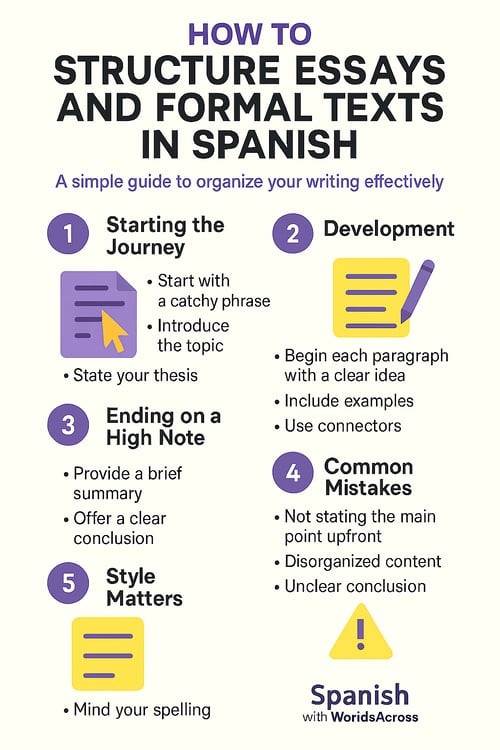How to structure essays and formal texts in Spanish
Hello, future Spanish expert! Have you ever wanted to write an essay or formal text but didn't know where to start? Don’t worry, it’s happened to all of us! At first, writing essays or more serious texts in Spanish may seem complicated, but today I’ll show you how to do it simply and clearly. Relax, it’s easier than you think!
Let’s get started!
1. Starting the Journey: The Gateway to Your Essay
The first part of your Spanish essays is the introduction. Here, you introduce the topic to your reader.
- Start with a catchy phrase: This helps grab the reader's attention.
Example: “¿Qué tan importante crees que es sumergirse en una cultura para hablar su idioma con fluidez?” - Introduce the topic: You should clearly state what your essay or formal text is about.
Example: “En este ensayo, vamos a descubrir la importancia de la inmersión cultural para aprender idiomas” - State your thesis: This is the main point of your essay, what you intend to prove.
Example: “Voy a argumentar que la inmersión cultural es clave para aprender un idioma de verdad.”
2. Development: The Heart of the Essay
The body is where you elaborate on your ideas. Here, each paragraph should include a relevant idea that supports your thesis. Let’s see how to do this:
- Begin each paragraph with a clear idea:
Example: “Uno de los beneficios de la inmersión cultural es que acelera nuestro proceso de aprendizaje” - Include examples to support your ideas:
Example: “Por ejemplo, muchos estudiantes de español aprenden de verdad al ver y escuchar películas típicas” - Use connectors to ensure your text flows smoothly:
Examples include: "Por lo tanto," "sin embargo", "así mismo", "por ello", etc.
Extra Tip: Try to keep your paragraphs under five sentences. Remember, clarity is more important than length.
3. Ending on a High Note
Whether you’re writing essays or formal texts in Spanish, make sure to include a solid conclusion. In this section, reiterate the main ideas and share your final opinion or reflection.
- Provide a brief summary:
Example: “En resumen, sumergirse en la cultura de un país es una de las mejores maneras de aprender su idioma.” - Offer a clear conclusion:
Example: “Por eso, es fundamental incluir la inmersión cultural en nuestro proceso de aprendizaje de español”
4. Style Matters: Formatting with Purpose
When writing essays or formal texts in Spanish, it’s equally important to express your ideas clearly and present them neatly. Here are some tips to make your texts easy to read:
- Control Length: Overloading your text can bore the reader. Aim for short paragraphs that clearly convey your message. A brief, clear paragraph is better than a long, confusing one!
- Mind Your Spelling: A typo in a casual chat is fine, but for formal texts in Spanish, good spelling is crucial. If you need help, use online spelling checkers and tools to lend a hand.
- Alignment and Font Size: Make sure the text is left-aligned or justified. Choose a font size that is neither too large nor too small.
5. Common Mistakes and How to Avoid Them
Congratulations! Now you have several tools to write essays or formal texts in Spanish like a pro. To help you advance even faster, here are some common mistakes to avoid:
- Not stating the main point upfront: The introduction is key to letting the reader know what your text is about. Be clear when explaining the main point.
- Disorganized Content: Mixing different ideas in one paragraph or failing to organize them can cause confusion. Make a list of your ideas before you start writing. This will help you organize them better.
- Unclear Conclusion: End your essay strongly and encourage reflection or action. The reader should take away the main message of your writing.

Ready to Shine: Let’s Get Writing!
Great job! Now, there’s no essay or formal text you can’t handle. Remember three things: clearly state your main point in the introduction, organize your ideas well in the body, and end with a conclusion that leaves an impression. Writing essays and formal texts may seem challenging at first, but with practice and patience, you’ll master it! And if you ever have doubts, this guide will always be here to help.
See you soon!



